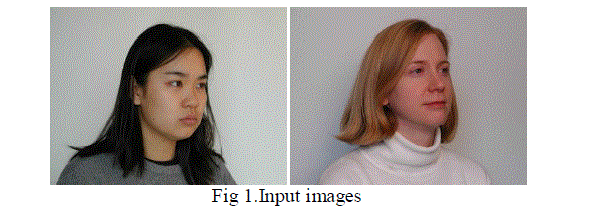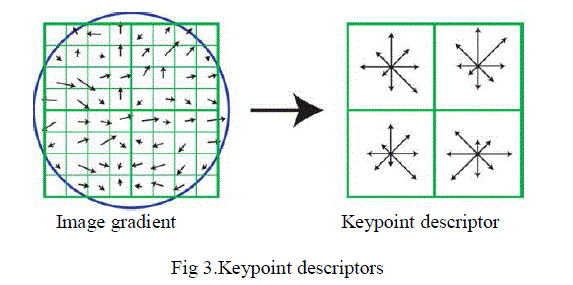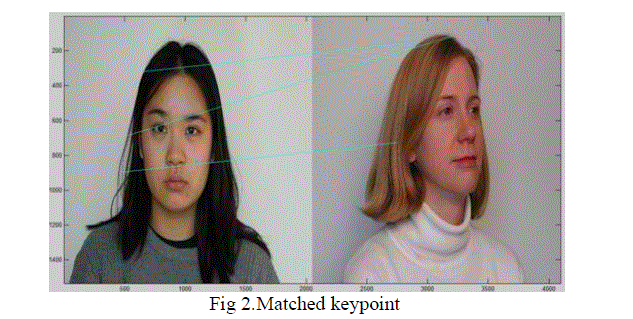Keywords
|
| Digital image forensics; Region Duplication Detection, Image Feature Matching, Keypoints |
INTRODUCTION
|
| The process of creating fake image has been tremendously simple with the powerful computer graphics editing software such as Adobe photoshop , corel paint shop and GIMP. There are different types of forgeries like image retouching ,image splicing and copy move attack .The existing method is machine learning which requires minimal user interaction .The technique is applicable to images containing two or more people and requires no expert interaction for the tampering decision. Proposed method generates distinctive invariant features from images that can be used to perform reliable matching between different views of an object or scene.. Image retouching does not affect much because it increases the intensity of the images. Image splicing is the morphing of two or more images.Copy move attack is more or less similar to image splicing in the fact that both techniques modify certain image region with another image. |
RELATED WORK
|
| A common manipulation in tampering the digital images is known as region morphing, where a cluster of pixels is copied and pasted to a different area in the same image. In recent years several methods have been proposed to detect the morphed areas for the purpose of image forensics. These methods are more effective for the detection of region copy-move, where a group of pixels is copied to another location of the same image. |
| A copy move forgery a portion of an image is copied to different location on the same image. It is difficult to distinguish and detect because the copied part has the properties like noise, colour and texture ,will be compatible with the rest of the image. One method for detecting the copy-move forgery is by block-matching procedure, which first divides the image into overlapping blocks. It hence detect the image blocks that where duplicated, instead of detecting the whole duplicated region. Since the copied region would consist of many overlapping blocks and moving the region means moving all the blocks by the same amount ,the distance between each duplicated pair would be the same. In this way the decision of forgery can be made and detected. |
| Keypoints and features based on the SIFT algorithm are used to account for illumination changes in the detection of copy-move region duplication. Here we describe a SIFT matching based detection method that locate the duplicate keypoints with rotation, scaling and shearing . . But similar to, it does not provide the exact extent and location of the detected duplicated region, but only displays the matched keypoints[1]. This technique is largely applied to simple forgeries where humans couldn’t find any difficulty in finding the duplicated region and the performance on highly challenging realist forgery images is largely unknown. The first step in collecting the image keypoints is to identify the distinctive image transform and robust to scaling and rotation. This is achieved by identifying the extrema in scale space detection and the orientation is assigned to all the keypoints.The number of keypoints should be less than the pixels, thus subsequent computation will not be wasted at locations with little image information. At each keypoint, a SIFT feature vector is generated from the normalized histograms of local gradients in a neighbourhood of pixels of that keypoint[2]. The size of the neighbourhood is determined by the scale of the keypoint, and all gradients are aligned with the dominant orientation at the keypoint. From the illuminant based technique[3] the texture and the edge features are extracted and which is then given to the machine learning approach for the automatic decision making. The classification performance using SVM meta-fusion classifier is promising. Interpretation of the illumination distribution as object texture for feature computation .An edge based characterization for illuminant maps which detect edge attributes. The creation of benchmark dataset should contain 100 skilfully created forgeries and 100 original photographs. |
| The keypoints [4] and feature based on scale invariant feature transform(SIFT) are used to account for illumination changes in the detection of copy-move region duplication. The robustness of SIFT keypoints and features to image distortions is not fully exploited, which prevents this method from being extended to detect affine transformed duplicated regions. Image content is transformed into local feature coordinates that are invariant to translation, rotation,scale and other imaging parameter. |
 |
| Proposed method detects the distorted duplicated region in the following modules: |
| ïÃâ÷ Finding Image Keypoints |
| ïÃâ÷ Keypoints Matching |
| ïÃâ÷ Eliminating Mismatched keypoints |
| ïÃâ÷ Estimation of Affine Transform |
| ïÃâ÷ Identifying Duplicated Regions |
| A. Finding image keypoints |
| To extract the keypoints SIFT algorithm is used and it consist of following steps:- |
| 1.Scale space peak selection |
| This helps in identifying the location of peaks in scale space using the different smoothing version of the same image. By varying the size of an image the interest point can be detected. The scale space is defined by L(x, y, σ) and Gaussian filter by G(x, y, σ) with an input image I (x, y). Smoothening by Gaussian filter zero crossing appear. When increasing the scale the zero crossing disappear .Given the scale space, the scale decreases and the zero crossing break into two and merge each other. The whole spectrum of zero crossing is taken and interpreted and made into more zero crossing. The nodes which is less stable is eliminated and top level description of several signals is obtained using the stability criteria. For 2D we go for Laplacian of Gaussian(LoG) and it is obtained using different sigma value. When looking at 3x3 neighbourhood we look the point above and below the centre point .comparing the centre point with all other 27 points the maxima and minima is obtained .All scales must be examined to identify Scale-Invariant Features. An efficient function is to compute the laplacian pyramid (Difference of Gaussian).The . The relationship between D and G can be understood from the heat diffusion equation |
 |
| 3. Orientation assignment |
| One or more orientations are assigned to each keypoint location based on local image gradient directions. All future operations are performed on image data that has been transformed relative to the assigned orientation, scale, and location for each feature, thereby providing invariance to these transformations. To achieve rotation invariance compute central derivatives gradient magnitude and direction of L(smooth image) at the scale of keypoint (x,y). Create histogram of gradient directions, within a region around the keypoint, at selected scale |
 |
 |
| Create a weighted direction histogram in a neighbourhood of a keypoint of 36 bins. Each of this will be of 10 degrees. Select the peak as direction of the keypoint. Introduce additional keypoints (same location) at local peaks(within 80% of maximum peak) of the histogram with different direction. In the case of peaks within 80% of highest peak, multiple orientation assigned to keypoints. About 15% of keypoints has multiple orientations assigned which significantly improves stability of matching. |
| 4. keypoint descriptor |
| Possible descriptor Store intensity samples in the neighbourhood which is sensitive to lightening changes ,3D object transformation and use of gradient orientation histograms.Each histogram entry is weighted by gradiant magnitude and a Gaussian function with σ equal to 0.5 time the width of the descriptor window . To ensure the obtained feature vector invariant to rotation and scaling, the size of the neighbourhood is determined by the dominant scale of the keypoint, and all gradients within are aligned with the keypoint’s dominant orientation dominant orientation. Furthermore, the obtained histograms are normalized to unit length, which renders the feature vector invariant to local illumination changes. |
 |
| B. Matching key-point |
| The detected keypoints are matched using Scale –Rotation invariant Pattern Entrophy algorithm.Its effectiveness is mainly based on large dataset. we describe an algorithm, namely Scale-Rotation invariant Pattern Entropy (SRPE), for the detection of near-duplicates in large-scale database. SR-PE is a novel pattern evaluation technique capable of measuring the spatial regularity of matching patterns formed by local keypoints. To demonstrate our work in large-scale dataset, a practical framework composed of three components: bag-of-words representation, local keypoint matching and SR-PE evaluation, is also proposed for the rapid detection of near-duplicates. |
| The followings steps are:- |
| 1.Find a set of distinctive key-points |
| 2.Define a region around each key-point |
 |
| 3.Extract and normalize the region content |
| 4. Compute a local descriptor from the normalized region |
| 5.Match local descriptors |
| C. Eliminating the mismatched keypoints |
| We use SIFT for matching the keypoints with the help of affine transform parameters and it is unreliable for large mismatched keypoints.To find out the unreliable keypoints we use Random Sample Consensus which run N times to detect the unreliable keypoints and the following steps are:- |
| 1. Select sample of m points at random |
| 2. Calculate model parameters that fit the data in the sample |
| 3. Calculate error function for each data point |
| 4. Select data that support current hypothesis |
| 5. Repeat sampling |
| This measure performs well because correct matches need to have the closest neighbour significantly closer than the closest incorrect match to achieve reliable matching. For false matches, there will likely be a number of other false matches within similar distances due to the high dimensionality of the feature space. We can think of the second-closest match as providing an estimate of the density of false matches within this portion of the feature space and at the same time identifying specific instances of feature ambiguity. we obtain two sets of region pairs corresponding to scale and rotation channels respectively. |
| D. Estimation of Affine transform |
| To generalize transforms such as rotation, scaling and shearing that are supported in most photo-editing software, we model the distortion as affine transform of pixel coordinates. Given two corresponding pixel locations from a region and its duplicate as |
 |
| respectively, they are related by a 2D affine transform specified by a 2x2 matrix T and a shift vector x0 as: |
 |
| or more explicitly. We need at least three pairs of corresponding keypoints that are not collinear. In practice, due to imprecise matching, it may not be satisfied exactly, and we form the least squares objective function using matched keypoints and searching for T and x0 that minimize it. |
| E. Identifying duplicated regions |
| Estimate of the original and duplicated pixels is compared and a more effective measure is obtained by comparing the distance of the closest neighbour to that of the second-closest neighbour. If there are multiple training images of the same object, then we define the second closest neighbour as being the closest neighbour that is known to come from a different object than the first, such as by only using images known to contain different objects. This measure performs well because correct matches need to have the closest neighbour significantly closer than the closest incorrect match to achieve reliable matching. For false matches, there will likely be a number of other false matches within similar distances due to the high dimensionality of the feature space. We can think of the secondclosest match as providing an estimate of the density of false matches within this portion of the feature space and at the same time identifying specific instances of feature ambiguity. |
CONCLUSION
|
| Region duplication is becoming an important issue and our paper describe an efficient method to solve this problem.Our method is based on SIFT features which helps in matching the keypoint.For elliminating the unreliable keypoints RANSAC algorthim performs well because correct matches need to have the closest neighbour significantly closer than the closest incorrect match to achieve reliable matching. For false matches, there will likely be a number of other false matches within similar distances due to the high dimensionality of the feature space.The result conclude that it is effective and robust in conditions like noise, and different JPEG qualities. Compared to other method where only matched key points are shown as detection results, we further estimate the transform between duplicated regions based on SIFT features and recover the complete region contours using correlation map.Thus for future work,we consider by using different different specification such as PCA-SIFT or histograms of oriented gradients, and combining with other detection schemes based on intrinsic signal statistics patterns to provide strong cues when image keypoints and features are not sufficient. |
| |
References
|
- B.L.Shivakumar1 Lt,Dr. S.SanthoshBaboo,” Detecting Copy move forgery in digital images:” A Survey and Analysis of current Method, Global Journal of computer science and technology,Vol. 10 Issue 7 Ver.1.0 September 2010.
- Xunyu Pan and SiweiLyu, “Region duplication detection using image feature matching”,IEEE Transaction on Information forensics and security, VOL. X, NO. X, XX 2010.
- WeiqiLuo, Jiwu Huang and GuopingQiu “Robust Detection of Region-Duplication Forgery in Digital Image”, IEEE Transaction on Information forensics and security, 2006.
- SevincBayram, HusrevTahaSencar ,NasirMemon “An efficient and robust method for detecting copy move forgery” IEEE Transaction on Information forensics and security,2009.
- A.C. Popescu and H.Farid. “Exposing digital forgeries by detecting duplicated image regions”. Technical Report TR2004-515, Department of Computer science, Dartmouth College, 2004.M. Young, The Technical Writer's Handbook. Mill Valley, CA: University Science, 198
|